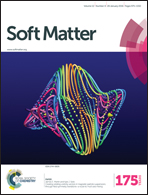A flow visualization and superposition rheology study of shear-banding wormlike micelle solutions†
Abstract
In this paper, we use rheometry and flow visualization to study the dynamics of the interface between shear bands in a wormlike micellar solution sheared between concentric cylinders, i.e., in a Taylor–Couette (TC) cell, and to evaluate the stress diffusion coefficient and the stress correlation length in the Johnson–Segalman model. Two wormlike micellar solutions are studied: an aqueous solution of CTAB–NaNO3 and a solution of CPCl–NaSal in brine. These systems are highly elastic, exhibit Maxwellian behavior in linear viscoelasticity experiments, and shear banding in nonlinear experiments [S. Lerouge, et al., Soft Matter, 2008, 4, 1808–1819, M. A. Fardin, et al., Soft Matter, 2012, 8(39), 10072–10089, P. Ballesta, et al., J. Rheol., 2007, 51, 1047]. A large, custom-built, computer controlled TC cell allows us to rotate both cylinders independently and to visualize the flow in the r–z plane using a CCD camera. At low shear rates, the flow is stable and the fluid appears homogeneous throughout the gap between the cylinders. Above a critical shear rate, a shear banding transition occurs. This manifests itself in the formation of two distinct bands in the r–z plane, with an interface between the two bands. For sufficiently high ramp speeds, multiple steps of interface evolution are identified, as noted by Radulescu, Lerouge, and others [O. Redulescu, et al., Europhys. Lett., 2003, 62, 230, S. Lerouge, et al., Soft Matter, 2008, 4, 1808–1819]. We quantify the interface travel using direct visualization and use this measure, as well as superposition rheometry [P. Ballesta, et al., J. Rheol., 2007, 51, 1047], to determine the stress diffusion coefficient D and the stress correlation length ζ in the Johnson–Segalman model. These parameters are evaluated at different temperatures, shear rates, and gap sizes. We find that the stress diffusion coefficient and the stress correlation length exhibit a strong dependence on the gap of the Taylor–Couette cell for both shear-banding systems. For the CTAB–NaNO3 system, we report a linear dependence of the stress diffusion coefficient on temperature for the parameter range considered. In addition, we find that for this system, the stress diffusion coefficient is independent of shear rate. For the CPCl–NaSal system, we observe the same color changes in the sample reported by others on extended light exposure; however, we find that different histories of light exposure do not affect the measured stress diffusion coefficient.


 Please wait while we load your content...
Please wait while we load your content...